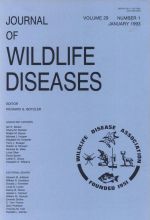Fat soluble vitamins E and A (quantified as α-tocopherol and all-trans retinol, respectively) were measured in plasma samples from 274 captive cranes from four institutions and five free-ranging birds. Ages ranged from 4 mo to 80 yr, and all 15 crane species were represented. Captive cranes had a mean ± standard error (SE) of 6.57 ± 0.82 μg/ml α-tocopherol; migrating greater sandhill cranes (Grus canadenis tabida) had a plasma concentration of 3.71 ± 0.22 μg/ml. Sex and age differences were not significant, but crane species that evolved in temperate habitats had higher circulating levels of α-tocopherol than tropical or subtropical species. Mean ± SE retinol values were 0.69 ± 0.05 μg/ml in captive cranes, and 0.66 ± 0.08 μg/ml in free-ranging cranes; values did not differ significantly by sex, age, or species. Dietary vitamin E concentrations were significantly correlated with plasma α-tocopherol levels in a logarithmic relationship. Dietary selenium at 0.5 mg/kg was associated with decreased circulating a-tocopherol concentrations.
How to translate text using browser tools
1 January 1993
VITAMIN E IN CRANES: REFERENCE RANGES AND NUTRIENT INTERACTIONS
Ellen S. Dierenfeld,
Christine D. Sheppard,
Julie Langenberg,
Claire Mirande,
Jeff Spratt,
F. Joshua Dein

Journal of Wildlife Diseases
Vol. 29 • No. 1
January 1993
Vol. 29 • No. 1
January 1993
crane
diet
nutrition
selenium
vitamin A
vitamin E




